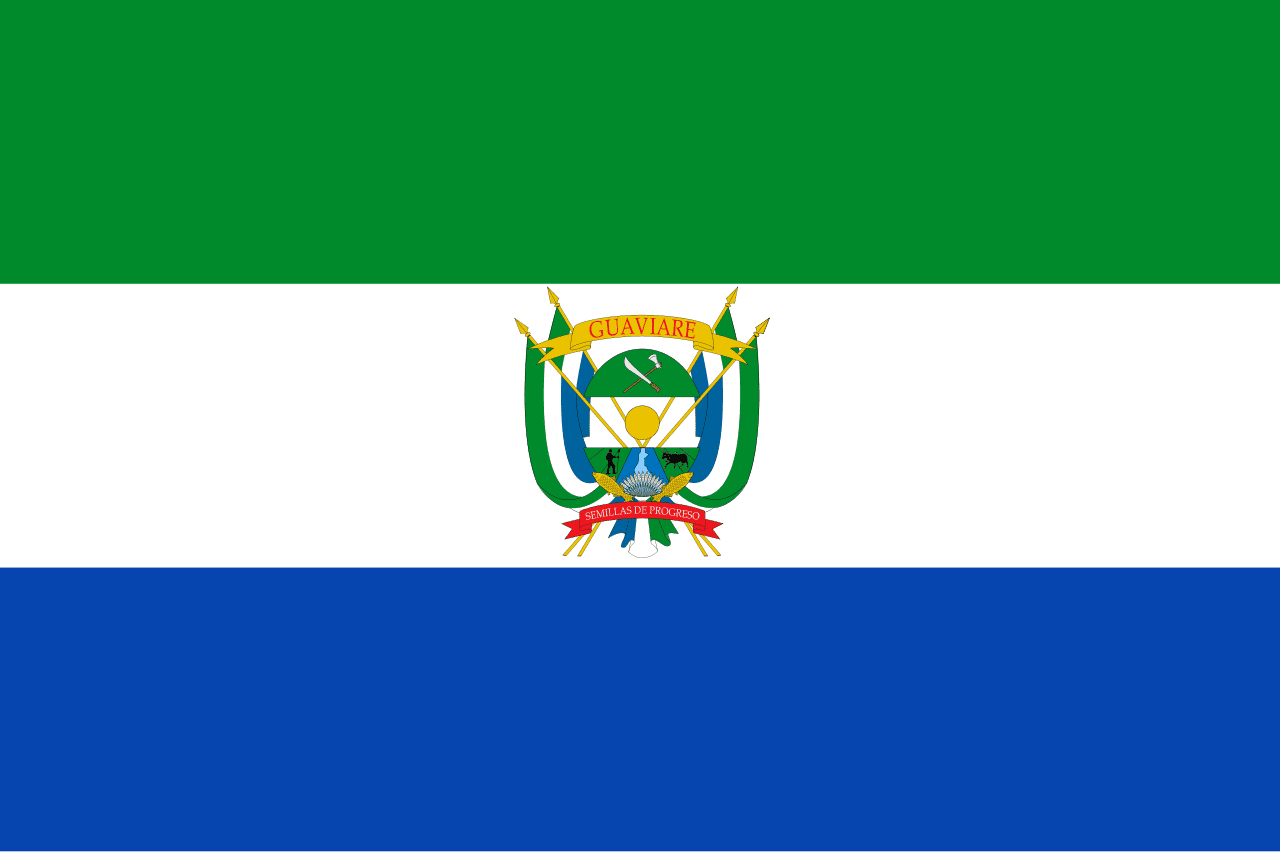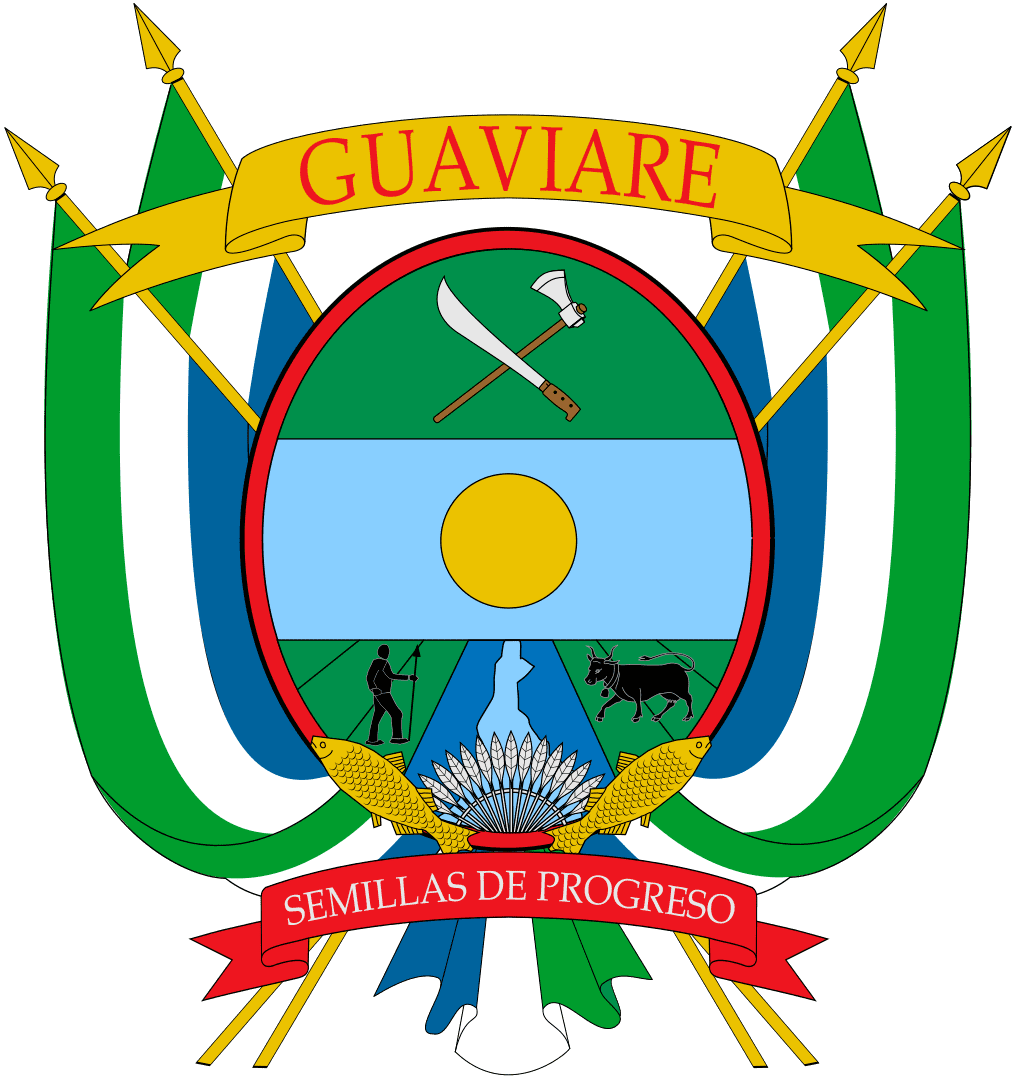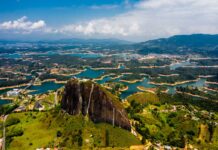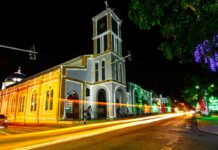Guaviare es uno de los 32 departamentos que conforman la República de Colombia. Esta compuesto por 4 municipios de los cuales su capital es el municipio de San José del Guaviare. Se encuentra ubicado en la región de la Amazonia al este del país.
| SIMBOLOS DEL DEPARTAMENTO |
Bandera del Guaviare |
Escudo del Guaviare |
| Clic aquí para escuchar el: Himno del Guaviare |
| DATOS GENERALES DEL GUAVIARE |
| País: Colombia. |
| Entidad: Departamento. |
| Capital: San José del Guaviare |
| Gentilicio: Guaviarense |
| Lema: Hoy busco libertad para ti |
| Fundación: 23 de diciembre de 1977 |
| Erección como departamento: 4 de julio de 1991 |
| Cantidad de Municipios: 4 |
| Sitio web oficial: guaviare.gov.co |
Historia del Departamento del Guaviare:
El actual territorio del departamento de Guaviare ha sido habitado desde la época prehispánica por diversas comunidades indígenas, como los nukak, puinave, guayaberos, sikuani, cubeos, piratapuyos, desanos, tucanos y carijonas. Los kurripakos de la familia arawak también han ocupado estos territorios, viviendo en resguardos reconocidos por el Estado, con una población indígena que supera las cuatro mil personas. Sin embargo, los tinigua, ubicados al noroccidente del departamento, se extinguieron.
La colonización de la región se ha dado en diferentes etapas, desde el final del siglo XIX hasta la II Guerra Mundial, cuando se explotó el caucho en las selvas. En la década de 1960, se impulsó la colonización para la ganadería, plantaciones de cacao y pesca, dando origen al municipio de San José en 1976. La década siguiente marcó una significativa colonización para el cultivo de coca, impactando la vida y la historia del Guaviare. La población actual se acerca a los 100 mil habitantes.
Desde la conquista hasta los primeros años de la república, Guaviare fue parte de la provincia de Popayán, el departamento de Boyacá de la Gran Colombia (1821-1830), el Territorio del Caquetá (1830-1857), integrado al Estado Soberano del Cauca, y la comisaría especial del Vaupés en 1910. La ley 55 de 1977 creó la comisaría del Guaviare, segregándola del Vaupés, con capital en San José del Guaviare. El 4 de julio de 1991, la Asamblea Nacional Constituyente lo elevo a la categoría de departamento.
La colonización del Guaviare ha sido motivada por sus riquezas naturales, como balata, caucho, comercio de pieles, plantas y peces ornamentales, además del cultivo ilícito de coca.
División político-administrativa de Guaviare
El Departamento esta conformado por 4 municipios de los cuales San José del Guaviare es la capital. A continuación el listado de Municipios de Guaviare.
| Municipios | Categoría |
|---|---|
| San José del Guaviare | Municipio (Capital) |
| Miraflores | Municipio |
| El Retorno | Municipio |
| Calamar | Municipio |
Gastronomía de Guaviare
Gran parte de la gastronomía del Guaviare se encuentra ligada a los ríos, quienes han proporcionado una fuente segura de alimento durante muchos años a los habitantes de la zona, de igual manera la agricultura que se desarrolla en el lugar, así como la ganadería brinda otra gama de ingredientes que enriquecen la variada cocina del departamento. Algunas de las recetas más representativas del Guaviare son:
- Chicha de Moriche
- El pescado moquiado
- Chigüiro al Horno
- Casabe
- Mañoco
- Sancocho de Gallina Tapacura o Gumarra
- Dulce de mango verde
Conoce aquí la lista completa de recetas de la gastronomía del Guaviare
Ferias y Fiestas del Guaviare
Entre las ferias y fiestas del departamento encontramos el “Festival Internacional Yurupary de Oro” realizado en agosto en San José del Guaviare, el “Festival de colonias” que se realiza para celebrar las fiestas patronales de la capital y para rendir homenaje a las culturas de cada región, “El Festival de Verano el Caimán Rumbero” organizado en el corregimiento de El Capricho, en este mismo corregimiento también se celebra “Festival Guacamaya de Oro”, otro de los grandes eventos del año es “El Festival de Verano”, realizado en las playas del río Guaviare.
Conoce aquí la lista completa de festivales, ferias, fiestas y eventos del Guaviare
Sitios Turísticos del Guaviare
La riqueza natural que tiene el Guaviare así como el legado arqueológico y cultural de las culturas prehispánicas que habitaron y habitan el departamento lo han convertido en un destino turístico de ensueño para los amantes de la naturaleza y la cultura, entre los sitios turísticos del Guaviare destacan:
- La Reserva Nacional Natural Nukak
- El Parque nacional natural del Chiribiquete
- La “ciudad de piedra”
- Los Balnearios de Agua Bonita y Villa Luz
- Las pinturas rupestres del río Guayabero y del caño Dorado
- El raudal del Guayabero
- Aguas termales del Guaviare
Conoce aquí la lista completa de lugares turísticos de Guaviare
Economía del Guaviare
El Sector agropecuario es el principal motor económico legal del Guaviare, otras actividades de importancia son la ganadería y la pesca y luego, los cultivos de plátano, yuca, cacao, maíz, arroz, chontaduro, arazá, copoazú, uva caimarona, guaitutu o anón amazónico, cocona, seje, nuez de inchi y palma africana.
Gracias a la riqueza natural, cultural e histórica que posee el departamento el turismo ha ganado en los últimos años fuerza como un nuevo posible motor económico en la zona.
Leyendas y Mitos del Guaviare
Entre las leyendas y mitos que forman parte del imaginario de los Guaviarense se destacan las siguientes:
- La leyenda del Yuruparí
- El Pata de Tarro
- El Compadre Bototo
- El Motorista Sin Cabeza
- Mito del origen del mundo de los nukak makú.







